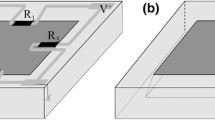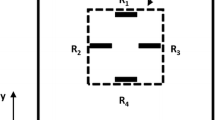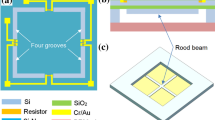Abstract
MEMS-based piezoresistive pressure sensors are widely popular due to advantages such as small size, low cost, simple fabrication, and DC output. In this work, the design simulation, fabrication process, and characterization of four pressure sensors with square diaphragms of edge-length 1,060, 1,280, 1,480, and 1,690 µm are reported. Several design principles such as appropriate boundary condition, piezoresistor placement, and fracture stress are considered in the design phase. The sensors have novel shaped polysilicon piezoresistors and equal diaphragm thickness of 50 µm. The sensors are fabricated simultaneously by putting the different designs on the same mask set so that the best design can be determined after characterization. The uncompensated and unamplified output response of the different sensors are reported at three temperatures (−5, 25 and 55 °C). Out of the four sensors with different diaphragm sizes, the sensor with a diaphragm edge length of 1,280 μm is found to have optimum characteristics. For the diaphragm with edge-length of 1,280 µm, in the pressure range of 0–30 Bar, sensitivity of 3.35–3.73 mV/Bar, non-linearity of <0.3 %, and hysteresis of <0.1 % are obtained. The different sensors can be used in the specified pressure range for suitable applications.

















Similar content being viewed by others
References
Aravamudhan S, Bhansali S (2008) Reinforced piezoresistive pressure sensor for ocean depth measurements. Sens Actuators A 142:111–117
Armbruster S, Schäfer F, Lammel G, Artmann H, Schelling C, Benzel H, Finkbeiner S, Lärmer F, Ruther P, Paul O (2003) A novel micromachining process for the fabrication of monocrystalline Si-membranes using porous silicon. In: Proceedings of 12th international conference on solid-state sensors, actuators, and microsystems, Boston, pp 246–249
Bao M (2005) Analysis and design principles of MEMS devices. Elsevier, Amsterdam
Berns A, Buder U, Obermeier E, Wolter A, Leder A (2006) AeroMEMS sensor array for high-resolution wall pressure measurement. Sens Actuator A 132:104–111
Chung GS, Kawahito S, Ishida M, Nakamura T, Kawashima M, Suzaki T (1991) High-performance pressure sensors using double silicon-on-insulator structures. Rev Sci Instrum 62(5):1341–1346
Guo S, Eriksen H, Childress K, Fink A, Hoffman M (2009) High temperature smart-cut SOI pressure sensor. Sens Actuators A 154:255–260
Herrera-May AL, Soto-Cruz BS, López-Huerta F, Aguilera Cortés LA (2009) Electromechanical analysis of a piezoresistive pressure micro-sensor for low-pressure biomedical applications. Rev Mex De Física 55:14–24
Kumar SS, Pant BD (2012) Design of piezoresistive MEMS absolute pressure sensor. In: Proceedings of the SPIE 8549
Kumar SS, Pant BD (2013) Effect of temperature on etch rate and undercutting of (100) silicon using 25 % TMAH. In: Proceedings of the international conference on emerging technologies micro to nano (ETMN), Goa
Kumar SS, Pant BD (2014a) Polysilicon thin film piezoresistive pressure microsensor: design, fabrication and characterization. Microsyst Technol. doi:10.1007/s00542-014-2318-1
Kumar SS, Pant BD (2014b) Design principles and considerations for the ‘ideal’ silicon piezoresistive pressure sensor: a focused review. Microsyst Technol 20:1213–1247
Kumar SS, Pant BD (2014c) Effect of orthotropic properties and clamping condition of diaphragm on the output of silicon piezoresistive pressure sensors. In: Proceedings of the 7th ISSS International conference on MEMS, smart material, structures and systems, Bengaluru
Li X, Liu Q, Pang S, Xu K, Tang H, Sun C (2012) High-temperature piezoresistive pressure sensor based on implantation of oxygen into silicon wafer. Sens Actuators A 179:277–282
Liu X, Lu X, Chuai R, Shi R, Suo C (2009) Polysilicon nanofilm pressure sensor. Sens Actuators A 154:42–45
Lou L, Zhang S, Park WT, Tsai JM, Kwong DL, Lee C (2012) Optimization of NEMS pressure sensors with multilayered diaphragm using silicon nanowires as piezoresistive sensing elements. IEEE J Micromech Microeng 22(5):055012-1–055012-15
Malhaire C, Barbier D (2003) Design of a polysilicon-on-insulator pressure sensor with original polysilicon layout for harsh environment. Thin Sol Films 427:362–366
Olszacki M (2009) Modelling and optimization of piezoresistive pressure sensors. Ph.D. Dissertation, Université de Toulouse, France
Pramanik C, Saha H, Gangopadhyay U (2006) Design optimization of a high performance silicon MEMS piezoresistive pressure sensor for biomedical applications. J Micromech Microeng 16:2060–2066
Thyagarajan V, Bhat KN (2013) Optimum location for piezoresistors with square diaphragm pressure sensor. In: Proceedings of 6th ISSS national conference on MEMS, smart material, structures and systems, Pune
Tsai HH, Hsieh CC, Fan CW, Chen YC, Wu WT (2009) Design and characterization of temperature-robust piezoresistive micropressure sensor with double-wheatstone-bridge structure. In: Proceedings of the symposium on design, test, integration and packaging of MEMS/MOEMS, Rome, pp 363–368
Wang Q, Ding J, Wang W (2005) Fabrication and temperature coefficient compensation technology of low cost high temperature pressure sensor. Sens Actuators A 120:468–473
Wei J, Sarro PM, Due TC (2008) A piezoresistive sensor for pressure monitoring at inkjet nozzle. In: Proceedings of the IEEE sensors, pp 2093–2096
Xu Y, Jiang F, Tai Y-C, Donzier E, Loomis WA, Liberman AD (2000) A surface micromachined nitride-diaphragm high-pressure sensor for oil well application. In: Proceedings of ASME International Mechanical Engineering Congress and Exposition, Orlando, Florida
Yameogo P, Heiba U, Bahari MA, Pons P (2009) Self calibrating pressure sensor for biomedical applications. In: Proceedings of IEEE sensors, pp. 691–694
Zhang YH, Yang C, Zhang ZH, Lin HW, Liu LT, Ren TL (2007) A novel pressure microsensor with 30-μm-thick diaphragm and meander-shaped piezoresistors partially distributed on high stress bulk silicon region. IEEE Sens J 7(12):1742–1748
Zhao Y, Zhao L, Jiang Z (2003) A novel high temperature pressure sensor on the basis of SOI layers. Sens Actuators A 108:108–111
Acknowledgments
Authors would like to acknowledge the generous support of the Director, CSIR-CEERI, Pilani. The authors would also like to thank all the scientific and technical staff of MEMS and Microsensors Group at CSIR-CEERI, Pilani. The financial support by CSIR through PSC-201: MicroSenSys project is gratefully acknowledged. The authors would also like to thank Dr. S. C. Bose and Mr. M. Santosh from IC design group for their help in sensor characterization.
Author information
Authors and Affiliations
Corresponding author
Rights and permissions
About this article
Cite this article
Kumar, S.S., Ojha, A.K. & Pant, B.D. Experimental evaluation of sensitivity and non-linearity in polysilicon piezoresistive pressure sensors with different diaphragm sizes. Microsyst Technol 22, 83–91 (2016). https://doi.org/10.1007/s00542-014-2369-3
Received:
Accepted:
Published:
Issue Date:
DOI: https://doi.org/10.1007/s00542-014-2369-3




